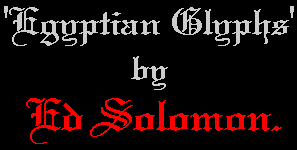
lecture20 solomon

| Story:
The High Priest of Ptha glistened with perspiration in the light of the oil soaked torch, which illuminated the darkness casting strange shadows on the walls of the inner sanctum of the temple. The young neophyte sat head bowed in the silence in readiness for the initiation as the High Priest slowly moved small pieces of papyrus into groups on the altar. Each of these small pieces depicted a single pictograph. Five plaques were presented and the neophyte was instructed to move them about. The face down plaques each contained a group of pictographs which we know today as hieroglyphics. Instructed to select any one plaque, he was to turn it over and mentally select one glyph and burn it into his consciousness as it would be of paramount importance if he were to be selected for the priesthood. The remaining plaques were secreted away beneath the altar and the High Priest began to chant as he pushed forward the small pieces of papyrus one at a time. A group of five were selected and the neophyte was asked to indicate if his selected glyph were among the five. Four sets were presented and not until the fifth set did the neophyte nod in the affirmative. The High Priest pointed to each glyph and hesitated momentarily over each finally coming to rest on one. It was the selected glyph and it was good. The young neophyte had passed the first of many tests. Working: This presentation is based on the work of David Zver who used the “Paul Fox Miracle Gimmick” principal with rune stones back in 1984 in the New Invocation. David used the Book of Runes and the clay stones to work this clever rune ruse. In this effect, only images of the Runes are used and I refer to them as 'tablets' (fig.3.). A grid of five squares by five squares uses all 25 rune stones and in this case the tablets indicated in the pictures (fig.4.). The plaques (figs.5 & 6) show five tablets VERTICALLY but not in the order that is shown in the grid. Each of the plaques is marked with a cut out to represent row/column 1-5 VERTICALLY, (you just have to remember which plaque represents which VERTICAL row it represents). When the individual 'tablets' are pushed forward and set out in groups of five they are selected from the grid in the HORIZONTAL rows. By knowing which plaque is representing which row it is easy to determine which of the selected glyphs has been chosen. It is always the odd glyph in the group. This grid comes from the 1996 edition of the "Eye of Horus", An oracle of Ancient Egypt by David Lawson. Published by St. Martin’s Press of New York. David is English and holds the copyright. If you want to find it the ISBN number is: 0-312-14528-4. This book is another of those specialty items found in the esoteric bookstores. Designed for self help and for eventual public readings for the devotees of the art, the book is quite attractive and very well written with lots of Egyptian History and rhetoric that will make the sitter feel like they have been transported back into the past and not just taken. The book comes with 25 clay tablets inscribed with the Glyphs shown the in diagram. If using the book, it could in be open to the key of the stone tablets on page 160 but the color grid I use is much nicer. The effect is charming using only the grid shown here. I made my whole set up by doing an over lay using a sheet of papyrus and then printed on top of that copy to achieve the working grid. In performance I mention the book and the fact that the clay tables were missing when I found the book at the flea market. (My favorite magic shop) The papyrus glyphs are flat and fit nicely into the small Egyptian box shown in figs.1 & 2. The photos of the clay tablets in the book are quite well done. Perhaps one day I will find a complete set. If you are unable to obtain the book, this whole set could be made up with drawings of the glyphs. There are various ways to cover the need for inclusion of your made up grid 'key' on the table. One possible way is to have it on the table with the glyphs facing the right way for you to read. On removing the pieces of parchment from the box or 'sacred container', they are laid out onto the grid, like glyph to like glyph, but placed the opposite way around making them face the spectator. Alternatively, you could have a mini sized key in an easy to read position behind the box or in it's lid (left upright but never to face the spectator). Prior to performance, the pieces of parchment are put into the box in specific order, so that when you remove them, you can virtually deal them into the correct places to form the grid. Click on each photo to see a larger version. For a printer friendly version of the above text CLICK HERE. Dragonskull Comment: British readers can obtain packs of superb papyrus (10 sheets per pack) from most branches of Hobbycraft, Europe's largest Arts & Crafts Superstore Chain. There is bound to be one near you. If you can't find one listed in the yellow pages, phone the Preston (Lancs) branch on 01772 661200 for possible info about a branch nearest to you (or type Hobbycraft into your favourite Search Engine, their site lists all 19 branches). |
| All the material in this lecture, on all pages, is copyrighted with all rights reserved to Ed Solomon, 2002. |